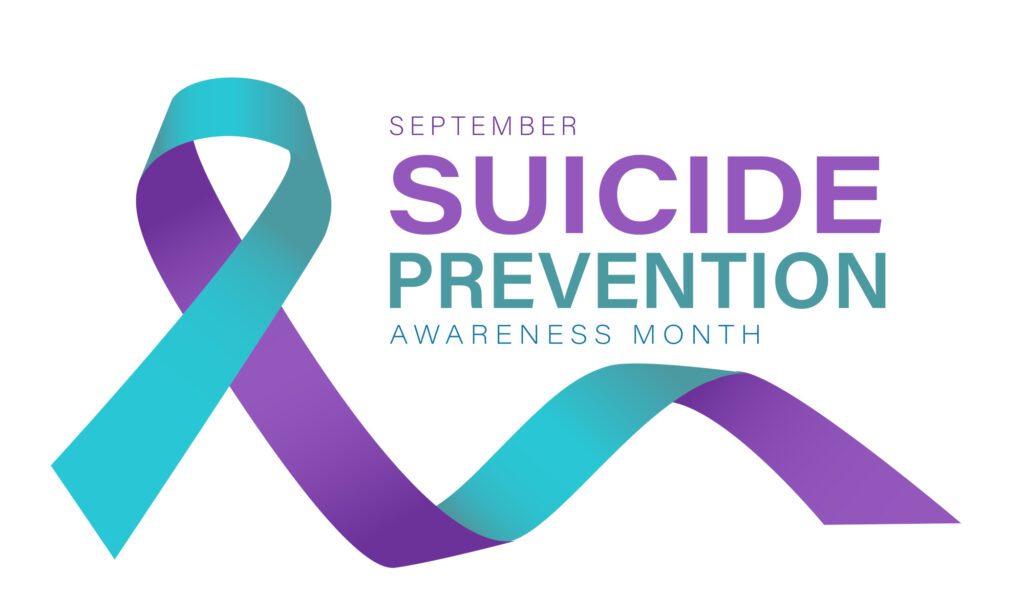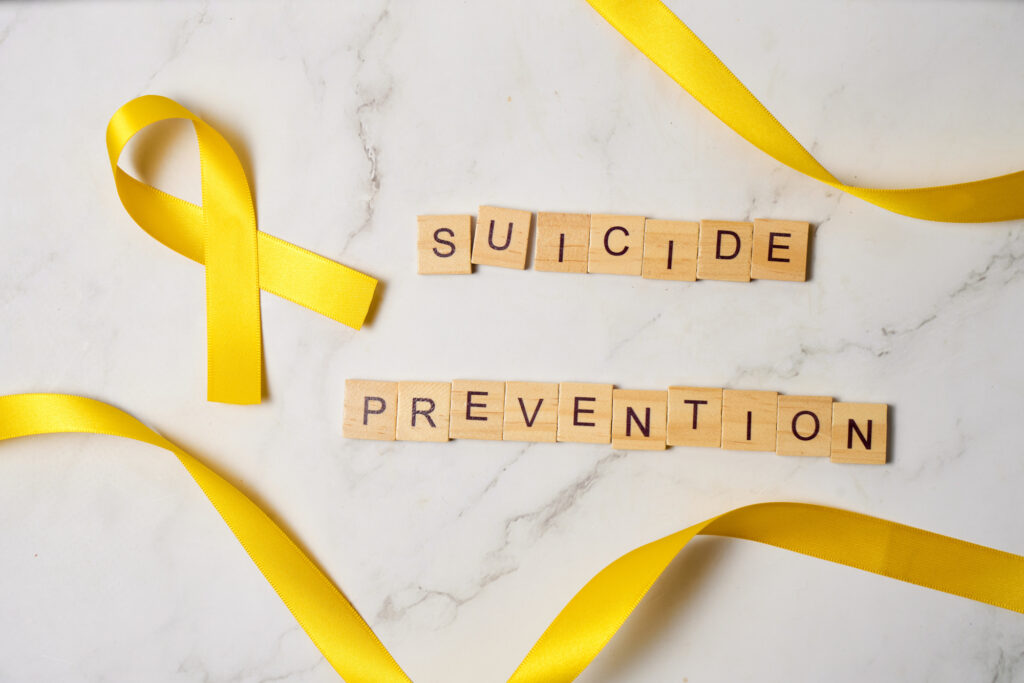Each year during the month of September, mental health professionals, community advocates, and organizations like the National Suicide Prevention Lifeline and the National Alliance on Mental Illness (NAMI) work to raise awareness about the growing prevalence of suicide in the U.S. and around the world.

Their collective efforts are known as National Suicide Prevention Month.
There are two primary goals of National Suicide Prevention Month:
Awareness
Organizers use messaging across social media and other platforms and host events to inform the general public about the most recent suicide statistics, suicide warning signs and risk factors, and the existence of suicide hotlines and support groups to help our at-risk community members.
Prevention
Organizers use messaging and host events to inform the general public on the actions steps they can take to prevent suicide in their communities and help friends and loved ones who may be suicidal get the help they need, when they need it.

Below, we’ll share the most recent and relevant statistics on suicide, then list the warning signs and risk factors we think everyone should know.
Suicide: Important Statistics
For some statistics on suicide in the general population, please see the Fast Facts section of this NAMI Suicide Prevention online resource. What we present next is teen-specific data from the American Foundation for Suicide Prevention (AFSP), the Centers for Disease Control (CDC), and the 2013-2023 National Youth Risk Behavior Survey (YRBS).
Teen Suicide Statistics: The Big Picture
- In 2023, 20% of all high school students seriously considered attempting suicide during the past year, 16% of high school students made a suicide plan during the past year, and 9% of high school students attempted suicide one or more times during the past year.
- In 2023, female students and LGBTQ+ students experienced more suicidal thoughts and behaviors than their male and cisgender and heterosexual peers.
- 8 out of 10 teens who attempt suicide display recognizable warning signs.
- Data indicates that over 3,500 teens in grades 9-12 attempt suicide every day.
- Suicide is the third leading cause of death among teens in the U.S. Teenagers and young adults die from suicide more than cancer, heart disease, AIDS, birth defects, stroke, pneumonia, influenza, and chronic lung disease
- Most teens who attempt suicide have a mental health diagnosis such as anxiety or depression
- Almost 10% of teens say they attempted suicide at least once
- Over 20% of LGBTQI+ teens say they attempted suicide at least once
- More than 6% of heterosexual students say they attempted suicide at least once
- Around 16% of students who questioned their sexuality reported at least one suicide attempt
- Almost 20% had serious thoughts of suicide
- Almost 50% of LGBTQI+ high school students had serious thoughts of suicide
- Around 14% of non-LGBTQI+ students had serious thoughts of suicide
- Over 30% of students who were not sure of their sexual orientation had serious thoughts of suicide
In addition to recognizing the size and scope of the problem, there are three things we want you to take away from these figures. First, our LGBTQI+ teens are at significantly increased risk of suicide, compared to their heterosexual/cisgender peers. Second, our teens with mental health issues are at increased risk of suicide, compared to peers without mental health issues. Third, eighty percent of teens who commit suicide show clear warning signs beforehand.
Teen Suicide: Warning Signs and Risk Factors
Since the vast majority of teens who attempt suicide display clear warning signs beforehand, it’s important to know what they are. Warning signs are factors that indicate a teen may be planning suicide – not at a distant point in the future, but soon.
Teens planning to commit suicide may:
- Talk about suicide
- Seek a means to commit suicide
- Share feelings of hopelessness
- State they feel no reason to go on living
- Feel trapped or in unbearable pain
- Say they feel like a burden to others
- Increase alcohol or drug use
- Engage in reckless behavior
- Become agitated and anxious
- Withdraw from friends and family
- Express extreme anger towards others, accompanied by talk of revenge
- Display extreme mood swings
It’s also crucial to recognize suicide risk factors. Warning signs are related to short-term danger, while risk factors are related to the bigger picture. The presence of risk factors increases the chance a teen will consider suicide at some point in their lives.
Risk factors include:
- Mental health issues:
- Feelings of hopelessness
- Impulse control issues
- History of trauma
- Major physical illnesses
- Previous suicide attempt(s)
- Family history of suicide
- Relationship problems
- Access to means of suicide
- Proximity to a suicide cluster
- Lack of family or social support
- Stigma related to mental illness and/or suicide
- Untreated mental health disorders
- Exposure – either directly or through media – to suicide attempts of others
It’s important to understand that the presence of risk factors does not mean a teen will commit suicide. However, when these long-term risk factors combine with short-term warning signs, parents should take action.
IMPORTANT NOTE: If you think a friend or loved one is in imminent danger of harming themselves, don’t wait. This goes for you, too: act immediately. Call 911 or the National Suicide Prevention Lifeline at 1-800-273-TALK (8255).

Why National Suicide Prevention Month Matters
The National Alliance on Mental Illness (NAMI) says:
“September is Suicide Prevention Month — a time to raise awareness of this stigmatized, and often taboo, topic. We use this month to shift public perception, spread hope and share vital information to people affected by suicide. Our goal is ensuring that individuals, friends and families have access to the resources they need to discuss suicide prevention and to seek help.”
What You Can Do: 5 Steps to Help Someone Considering Suicide
The National Action Alliance for Suicide Prevention and the 988 Suicide & Crisis Lifeline (formerly known as the National Suicide Prevention Lifeline) have 5 steps you – or anyone – can take to communicate with someone who may be suicidal.
- Ask. Evidence shows that people thinking about suicide – i.e. engaging in suicidal ideation – feel a sense of relief when another person checks up on them in a kind, considerate, and compassionate way. You can be that person.
- Be There. Experts agree that speaking to someone who is supportive and nonjudgmental makes people feel “less depressed, less overwhelmed, and more hopeful.” You can be that person for a loved one with depression, anxiety, or another mental health disorder.
- Keep Them Safe. Research indicates that removing access to lethal means can reduce the likelihood of a suicide attempt. You can be the person to keep your friends and loved ones safe by taking this simple step.
- Help Them Stay Connected. Studies reveal that when a person at risk of suicide has a supportive network of safe, caring, individuals, their sense of hopelessness – which is related to suicide attempts – can decrease, and help them take positive action for their own wellbeing. You can be part of that network of support for an at-risk friend or loved one.
- Follow Up. Consistent supportive contact can help prevent suicide attempts. This is particularly important for anyone recently discharged from mental health treatment. You can be the one who follows up and remind a friend or loved one you care and that they matter.
Those five steps may seem simple to you, but they can make all the difference for someone at risk of suicide. By taking those steps, you can #BeThe1To save a life.
Suicide Hotlines
Teens, parents, or friends of teens who need help can call or text the following numbers:
- The National Suicide Prevention Lifeline (24/7/365): 1-800-273-8255
- The Trevor Project Phone (24/7/365): 1-866-488-7386
- Trevor Project Text (7 days/wk, 6am-am ET, 3am-10pm PT): Text START to 678678
- The Trevor Project Chat: CLICK HERE
- The Crisis Text Line (24/7/365): Text CONNECT to 741741
- The Youth Yellow Pages TEEN LINE (6pm-10pm PT) 310-855-4673
- The Youth Yellow Pages TEXT: Text TEEN to 839863
Sources:
Centers for Disease Control and Prevention. Youth Risk Behavior Survey Data Summary & Trends Report: 2013–2023. U.S. Department of Health and Human Services; 2024.
NAMI. (2024). Suicide Prevention Month (SPM).






























































